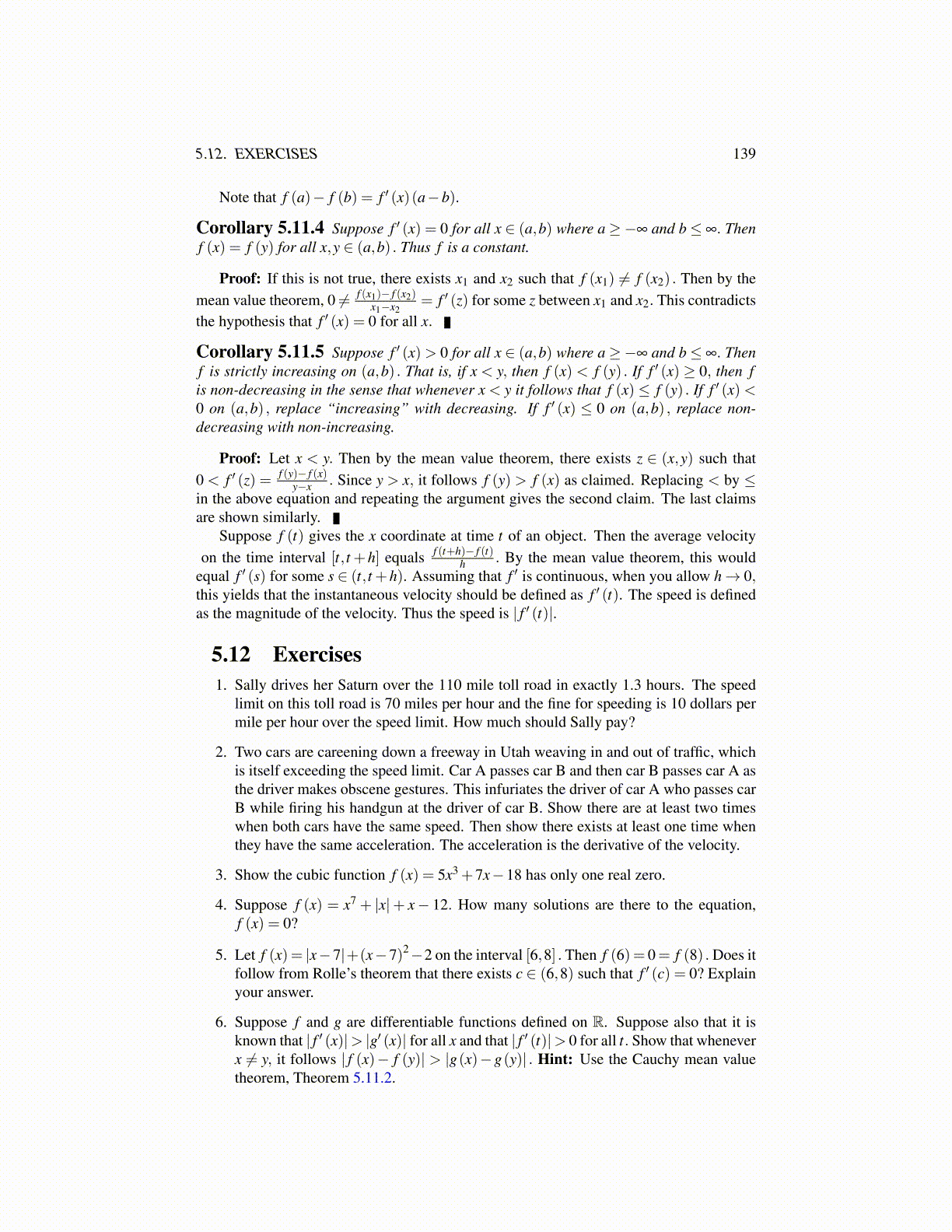
5.12. EXERCISES 139
Note that f (a)− f (b) = f ′ (x)(a−b).
Corollary 5.11.4 Suppose f ′ (x) = 0 for all x ∈ (a,b) where a ≥−∞ and b ≤ ∞. Thenf (x) = f (y) for all x,y ∈ (a,b) . Thus f is a constant.
Proof: If this is not true, there exists x1 and x2 such that f (x1) ̸= f (x2) . Then by themean value theorem, 0 ̸= f (x1)− f (x2)
x1−x2= f ′ (z) for some z between x1 and x2. This contradicts
the hypothesis that f ′ (x) = 0 for all x.
Corollary 5.11.5 Suppose f ′ (x)> 0 for all x ∈ (a,b) where a ≥−∞ and b ≤ ∞. Thenf is strictly increasing on (a,b) . That is, if x < y, then f (x) < f (y) . If f ′ (x) ≥ 0, then fis non-decreasing in the sense that whenever x < y it follows that f (x)≤ f (y) . If f ′ (x)<0 on (a,b) , replace “increasing” with decreasing. If f ′ (x) ≤ 0 on (a,b) , replace non-decreasing with non-increasing.
Proof: Let x < y. Then by the mean value theorem, there exists z ∈ (x,y) such that0 < f ′ (z) = f (y)− f (x)
y−x . Since y > x, it follows f (y) > f (x) as claimed. Replacing < by ≤in the above equation and repeating the argument gives the second claim. The last claimsare shown similarly.
Suppose f (t) gives the x coordinate at time t of an object. Then the average velocityon the time interval [t, t +h] equals f (t+h)− f (t)
h . By the mean value theorem, this wouldequal f ′ (s) for some s ∈ (t, t +h). Assuming that f ′ is continuous, when you allow h → 0,this yields that the instantaneous velocity should be defined as f ′ (t). The speed is definedas the magnitude of the velocity. Thus the speed is | f ′ (t)|.
5.12 Exercises1. Sally drives her Saturn over the 110 mile toll road in exactly 1.3 hours. The speed
limit on this toll road is 70 miles per hour and the fine for speeding is 10 dollars permile per hour over the speed limit. How much should Sally pay?
2. Two cars are careening down a freeway in Utah weaving in and out of traffic, whichis itself exceeding the speed limit. Car A passes car B and then car B passes car A asthe driver makes obscene gestures. This infuriates the driver of car A who passes carB while firing his handgun at the driver of car B. Show there are at least two timeswhen both cars have the same speed. Then show there exists at least one time whenthey have the same acceleration. The acceleration is the derivative of the velocity.
3. Show the cubic function f (x) = 5x3 +7x−18 has only one real zero.
4. Suppose f (x) = x7 + |x|+ x− 12. How many solutions are there to the equation,f (x) = 0?
5. Let f (x)= |x−7|+(x−7)2−2 on the interval [6,8] . Then f (6)= 0= f (8) . Does itfollow from Rolle’s theorem that there exists c ∈ (6,8) such that f ′ (c) = 0? Explainyour answer.
6. Suppose f and g are differentiable functions defined on R. Suppose also that it isknown that | f ′ (x)|> |g′ (x)| for all x and that | f ′ (t)|> 0 for all t. Show that wheneverx ̸= y, it follows | f (x)− f (y)| > |g(x)−g(y)| . Hint: Use the Cauchy mean valuetheorem, Theorem 5.11.2.